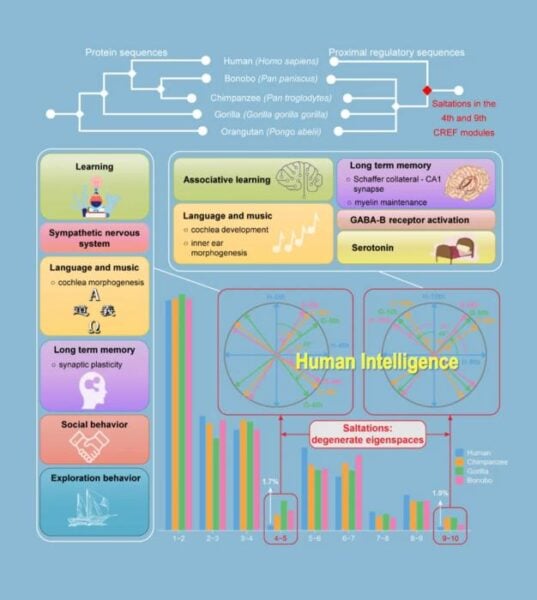Scientists have uncovered surprising genetic changes that may explain the extraordinary leap in human intelligence compared to our closest relatives. A new study published in Quantitative Biology shows that two dramatic “saltations” – evolutionary jumps – in gene regulation shaped our unique cognitive abilities, from language development to social cooperation, despite humans sharing 98.77% of our DNA with chimpanzees.
The research tackles one of science’s most fundamental questions: “What genetic changes made us uniquely human?” Rather than examining the protein-coding genes themselves, researchers analyzed the regulatory switches that control when and where genes are turned on or off. Their findings reveal how specific changes in these regulatory regions may have triggered the remarkable cognitive abilities that set humans apart from other primates.
What makes this approach groundbreaking is how it identified human-specific traits without any preconceived notions about what makes humans special. But how exactly did these regulatory changes create the minds that would eventually build civilizations, compose symphonies, and explore space?
The Regulatory Code Behind Human Intelligence
The research team, led by Xiaojie Li, Jianhui Shi, and Lei M. Li, developed a mathematical framework to analyze the frequency of regulatory elements – short DNA sequences that help control gene expression – across the genomes of humans, chimpanzees, bonobos, and gorillas.
Their analysis revealed that while most regulatory patterns remained relatively stable across species, two dramatic shifts occurred specifically in humans. These “saltations” appeared between what the researchers call the 4th/5th and 9th/10th “eigen-levels” – mathematical representations of regulatory patterns.
The saltations impacted genes controlling several crucial cognitive functions, including:
- Long-term memory formation and storage
- Cochlea and inner ear development (enabling language and music)
- Social behavior (allowing cooperative living)
- Multiple types of learning (visual, observational, and associative)
- Exploratory behavior (driving human creativity)
- Protective mechanisms for neurons
- Regulation of mood and happiness through serotonin
Mathematical Insights into Evolutionary Jumps
Rather than gradual changes accumulating over time, these saltations represent dramatic shifts that altered how multiple genes function together as networks. The researchers likened this process to physics concepts like phase transitions, where small changes in controlling parameters can trigger dramatic transformations in a system.
What makes this mathematical approach particularly valuable is its ability to reveal both gradual and saltational modes of evolution within the same framework. While protein sequences typically evolve gradually, the researchers found that regulatory networks can experience both gradual change and dramatic leaps.
This dual nature helps explain how species that share the vast majority of their DNA can exhibit such profound differences in cognitive capability.
Mobile DNA Elements: The Drivers of Change
A key finding of the study points to mobile DNA elements – particularly Alu elements and SVAs (SINE-R/VNTR/Alu) – as important drivers of these regulatory shifts. These elements can insert themselves into new locations in the genome, potentially altering how nearby genes are regulated.
The researchers found a remarkable increase in the number of regulatory motifs present on Alu elements in humans compared to chimpanzees and bonobos, particularly within the regulatory networks associated with intelligence. For example, the number of Alu-associated motifs increased by 43.5% at the 4th level and 25% at the 9th level when comparing humans to chimpanzees.
Several genes with human-specific insertions of these mobile elements stood out in the analysis. For instance, the BSG gene, which ranks 45th in importance at the 4th level in humans but much lower in apes, contains a human-specific Alu insertion. This gene plays a role in dendrite self-avoidance – a critical process for proper neural network formation and memory.
From Apes to Humans: A Regulatory Revolution
The study provides a fresh perspective on the longstanding puzzle of human uniqueness. Despite the minimal genetic differences between humans and our closest relatives, these specific regulatory changes appear to have enabled the emergence of human intelligence.
The findings suggest that while most evolutionary changes proceed gradually, as Darwin proposed, regulatory networks can occasionally experience dramatic jumps or “saltations” that yield profound phenotypic changes. The human brain, with its extraordinary cognitive abilities, may be the product of just such evolutionary leaps.
This computational approach to studying evolution offers a powerful new tool for understanding how species evolve. By focusing on regulatory networks rather than individual genes, researchers can capture the complex interactions that shape biological systems.
Looking ahead, this methodology could be applied to other species comparisons and different traits beyond intelligence. It might also inform research into neurodevelopmental disorders by highlighting the importance of regulatory regions in brain development and function. As we continue to explore what makes us human, this study suggests that the answer may lie not in what genes we have, but in how we regulate them.
If our reporting has informed or inspired you, please consider making a donation. Every contribution, no matter the size, empowers us to continue delivering accurate, engaging, and trustworthy science and medical news. Independent journalism requires time, effort, and resources—your support ensures we can keep uncovering the stories that matter most to you.
Join us in making knowledge accessible and impactful. Thank you for standing with us!

